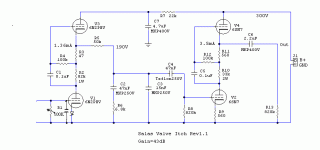Hello everybody,
I am about to build a Valve Itch since a while. Now I got all the parts together and I started building the power supplies.
As I understood the shield between the triods of the 6N2PEV (Pin 9) goes to ground. Is this also true for the elevated valve or does it go to the 150V point for the elevated heater instead? I did not find a reference in the thread so far.
Best
J.
I am about to build a Valve Itch since a while. Now I got all the parts together and I started building the power supplies.
As I understood the shield between the triods of the 6N2PEV (Pin 9) goes to ground. Is this also true for the elevated valve or does it go to the 150V point for the elevated heater instead? I did not find a reference in the thread so far.
Best
J.
Have anyone noticed if the 6N2PEV produces grid current below 1,2 V biasing? The datasheet suggests that it might do http://www.goldenmiddle.com/files/6N2PEV.pdf. An IR LED like https://www1.elfa.se/data1/wwwroot/assets/datasheets/ir908-7c_eng_tds.pdf or a 1N4148 might be around 0,7 to 1 V.
Depends on the valve and IR Led sample. If we can measure some mV across the 47K input we up the Vf with a proper component is the technique.
Salas I want to try a MM cart Linn K-9 specs:
Manual
Weight 7.1gr
Tracking force 1.5-2gr
Recommended load 47K
Output at 5cm/s at 1 kHz 4.5mV
Others see on the web
Compliance 12cu
Capacitance loading 200pF including arm cable
coil inductance 400mH
pick-up the same Audio Technica AT95E
The question is I have 100K trimmer to adjust the load resistance but I forgot how to do, could you help me please?
TIA
Felipe
Manual
Weight 7.1gr
Tracking force 1.5-2gr
Recommended load 47K
Output at 5cm/s at 1 kHz 4.5mV
Others see on the web
Compliance 12cu
Capacitance loading 200pF including arm cable
coil inductance 400mH
pick-up the same Audio Technica AT95E
The question is I have 100K trimmer to adjust the load resistance but I forgot how to do, could you help me please?
TIA
Felipe
Last edited:
I have the Hi-FiNews Analog Test LP "The Producer's Cut" Len Gregory, "The Cartrdige Man", I guess I have to use the scope what how?
Felipe. Go ahead and try. Your ears are the ultimate truth, they cant go wrong. If you hear anomalies it is probably MM sensitivity to capacistance loading, IE grid capacistance to input. If so try shortening cables or us low capacistance ones. You will go abit loudness but that is easily corrected with a HQ bridge.
This USSR input tube at this gain should give about 60pF Miller, add this to your cables pF expectation. If not having FFT capability, use ears while tweaking the input resistive load.
Short cables and you mighy be spot on. MM's has an ideal load capaistance that differs between them. Personally I have never agreed with those numbers. Maybe you do
They go average higher then ECC83 in AF but to my measurments they average 1,4 to 1,7 pF. A good ECC83 seldom goes over 0.9 on any grid.
Gm is just a constant refering to af and current. In this case it should be high but not always. Ideal in this case is a high gm/af tube as top and the same as lower. PEV is not so high gm but i suits the purpouse.
Gives Av=80 in the Itch's input stage. The upper part of a mu follower is actually a CCS maximizing gain and insulating rail nasties. Good enough gain for our purposes.
This USSR input tube at this gain should give about 60pF Miller, add this to your cables pF expectation. If not having FFT capability, use ears while tweaking the input resistive load.
TT cables 180pF + 60pF Miller = 240pF so 40pF more than manufacturer recommend including tonearm capacitance. Have I to not add capacitance right?
- Home
- Source & Line
- Analogue Source
- Valve Itch phono
